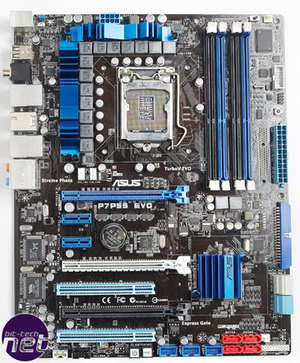Up close and personal
Unlike LGA1366s, LGA1156 CPUs have an integrated PCI-Express controller that supports up to 16 PCI-Express 2.0 lanes. It's then up to individual motherboard manufacturers to decide what type of slots will be powered by this controller, in all likelihood a single slot providing an x16 link, or two slots each providing x8 links.This means that unlike Intel's X58, the P55 comprises a single chip rather than a separate Northbridge and Southbridge. On the Asus P7P55D Evo, this resides in the left front corner under a small blue-anodised heatsink. As the CPU handles the high-speed PCI-Express interconnects directly, the P55 chip merely has to handle the slower, peripheral PCI-Express slots, PCI slots, on-board audio and the slower I/O buses such as USB 2 and SATA 3Gbps.
In terms of the P7P55D Evo, the P55 chip sat underneath the "Southbridge" heatsink ran so hot on our early sample, we had to position a fan blowing over it to prevent it overheating and crashing the system - that doesn't bode well for Asus should the layout design stay the same. Asus assures us the heat problem won't be there on the final revision. However, having said that, we've also witnessed other pre-production motherboards from other manufacturers running the P55 chipset without a heatsink on entirely!

Although the P55 chip provides six RAID-capable SATA 3Gbps ports (blue and red), Asus has also added a Marvell 88SE9123 controller that provides two RAID-capable SATA 6Gbps ports (in grey). There's also the usual collection of USB 2.0 and FireWire ports that you'd expect to find on a mid-range motherboard. The back panel provides two Gigabit Ethernet sockets, plus analogue and digital outputs for the on-board audio.
The Asus P7P55D Evo has three 16x PCI-Express 2.0 slots, two PCI-Express x1 slots and two PCI slots. The primary slot will provide 16 PCI-Express 2.0 lanes if it's the only slot in use, but if a card is also installed in the secondary slot (light grey), each will provide just eight PCI-Express 2.0 lanes. The dark grey slot below will provide only four PCI-Express 2.0 lanes, despite being a physical 16x slot; this is because it is connected to the P55 chip and not the PCI-Express controller integrated inside the CPU.
Unfortunately, despite having two 16x PCI-Express 2.0 slots, at the time of writing, Asus/Intel couldn't confirm whether the P7P55D Evo will support CrossFire or SLI.
The Asus P7P55D Evo also borrows several features from Asus' high-end Republic of Gamers series. These include on-board power and reset switches, plus Q-LED. The latter is a network of four LEDs that light up in different colours if a system error is detected, such as a faulty CPU. This might not sound like a big deal, but it could cut down on the time required to troubleshoot a misbehaving PC.

MSI MPG Velox 100R Chassis Review
October 14 2021 | 15:04









Want to comment? Please log in.